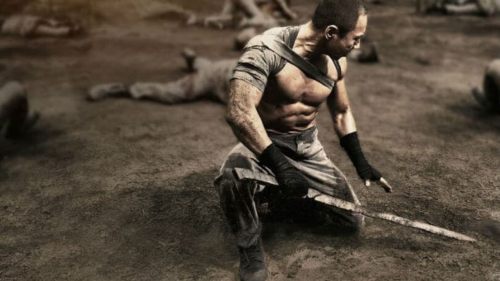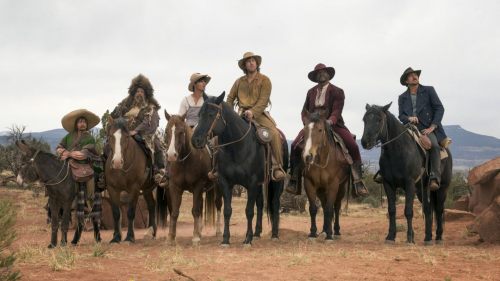POLAR Review: The Opposite Of Good
The early anticipation for Polar, based on its trailer, was that it would be Mads Mikkelsen’s answer to John Wick. A viewing of the movie itself reveals a crucial difference: John Wick is a compelling action-thriller with an inherent sense of justice, while Polar is a repellent, misanthropic, overstylized piece of junk.
Mikkelsen (who can currently and coincidentally also be seen in the far superior frozen thriller Arctic) deserves so much better than this brutally empty-headed schlocker, adapted from Victor Santos’ graphic novel Polar: Came From the Cold. He plays Duncan Vizla, a.k.a. “The Black Kaiser,” a top-notch assassin with the Damocles Agency whose medical pre-existing conditions list reads like an autopsy report. Bureaucracy is, in fact, a key motivator here, since Vizla is on the verge of retirement—which, in his case, means collecting an $8-million pension. But his corrupt and eccentric Damocles superior, Blut (Matt Lucas), prefers that Vizla die so he can keep the money, and sends a heavily armed and exaggerated squad after Vizla, who just wants to live out the rest of his life in peaceful, snowy Triple Oak, Montana (the movie never gets anywhere near the Poles). Yes, it’s another “Just when I thought I was out…” scenario, populated by characters who never develop beyond pencil sketches traced from far superior predecessors, and most of whom exist only to serve as collateral damage.
Polar is reminiscent of those Quentin Tarantino imitations from the ’90s—the ones whose creators looked at Reservoir Dogs and Pulp Fiction, in which humorous moments are interspersed with bursts of graphic violence, and decided that the graphic violence itself was what was funny. It attempts to present a gonzo world (when cadaverous Canadian character actor Julian Richings plays the most normal person—Vizla’s accountant—you know they’re aiming for nutz) but the violence is played for hard-edged, bone-crunching, splattery, torturous realism—and yet also for laughs. A lengthy sequence of innocent people being subjected to graphic, extended murder is actually presented as a comic montage, the explosions of blood and shattered body parts treated as sight gags. Some of these victims are dumb punk kids and another is grotesquely fat, which is supposed to make it OK to chuckle at their deaths, I guess. At one point, the filmmakers even try for a joke by having Vizla shoot his own dog (take that, John Wick!).
All the shooting, slicing and bashing of both good and bad guys is depicted by director/music-video veteran Jonas Åkerlund with the kind of visual flourishes that were once called “MTV style” before permeating too much of the feature-film scene: Lots of harsh, contrasty colors, hyperactive, senseless cutting, pixilated flashbacks and fetishistic close-ups of everything from weapons to general-store doorbells. Åkerlund and screenwriter Jayson Rothwell (who, with this and Silent Night, the sort-of remake of …Deadly Night, is becoming a specialist in cold-climate cruelty) are so anxious to get you off that they never attempt to seduce you in with interesting, empathetic characters, or a sense that the violence means anything.
They at first seem to be tossing a tiny bone in that direction with the introduction of Vizla’s Triple Oak neighbor Camille (Vanessa Hudgens). She’s supposed to represent the possibility of redemption for Vizla, but anyone familiar with this kind of film will quickly realize why she’s really here. Not to give too much away or anything, but if a female character’s sole purpose is to be kidnapped and tortured to motivate the hero, but doesn’t actually die, is that still considered “fridging”? And this isn’t even the most objectionable part of her role; that arrives when Camille recalls being raped at age 13, and the movie gets all somber and serious and pretends sympathy for her, when the camera has spent the previous 45 minutes aggressively leering at every female buttock and breast it can find.
So to forestall the inevitable arguments, what separates Polar from movies like the Deadpool duo, which take equal glee in a raunchy attitude and the destruction of the human body? I’d say it boils down to this: Beyond successfully creating a sense of alternate reality that takes the curse off the brutality, the Deadpools establish at least a few central characters with honest emotions and inclinations other than causing mayhem. No one in Polar has any purpose or motivation beyond killing other people, or becoming their victims, and all the extreme violence is given the same weight—i.e., none.
The Deadpools are also a lot more clever and creative; there isn’t a single beat in Polar that hasn’t been seen before in many other, much better films. OK, there is one fresh bit, involving laser-glove-controlled machine guns, but you can see that in the trailer and spare yourself from the rest of the movie. Even Blut’s frequent profane threats against Vizla exhibit no wit or imagination, leaving the impression that the filmmakers think it’s still a shocka just to have “fuck” in every other line of dialogue. (As if attempting to offend every possible group, a couple of close-ups reveal the fey, sadistic Blut tottering around in high heels.) A last-minute twist attempts to put a revelatory spin on the storyline, but it doesn’t work because it makes no sense in the context of what has come before. Polar then closes with credits that scroll downward, and as a gesture whose “edginess” is well past its sell-by date, it’s a perfect closer and emblem of the movie that has preceded it.



